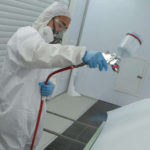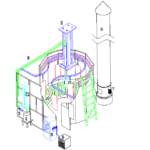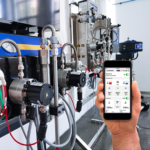For any type spray painting system, cleaning pretreatment is a MUST for guaranteed surface finishing quality. Either by rinsing or electrostatic blowing, the sole purpose is to make workpiece clean enough to meet with painting requirement. Despite the traditional cleaning solutions, CO2 snow cleaning is more and more requested for its simple structure and eco friendly advantages.
CO2 Snow Cleaning Introduction
CO2 snow cleaning is a process of blasting CO2 from gas to dry ice state softly and gently. During CO2 snow blasting, liquid CO2 is converted into solid CO2 snow particles with a diameter of between 1 to 100 µm, via thermodynamic and physical processes. These CO2 snow particles from dry ice have a temperature of -78.5 °C. CO2 snow particles are added proportionally to the compressed air. The acceleration of the particles is achieved through the compressed air flow in a special nozzle.
CO2 snow particles cool the impurities abruptly which leads to a separation of these from the substrate. Due to the sudden sublimation of the CO2 particles, small surges in pressure are created. These pressure surges release micro impurities on surfaces, even in the pores. By blasting along the surface impurities are removed from the surface and disposed of. A precision cleaning, especially for oil and grease, is accomplished due to the physical solubility of the organic properties in CO2. The compressed air flow aids the removal of the impurities.
CO2 Snow Cleaning Advantages
The patented CO2 snow jet cleaning process allows dry, environmentally friendly, residue-free cleaning of sensitive areas. By using a supersonic cleaning jet, maximum cleaning performance can be achieved with minimum CO2 consumption. These features, as well as the possibility of direct supply with liquid CO2, qualify the process especially for automated applications. The solutions offered are versatile and range from mobile cleaning systems such as the JetWorker to ready-to-install cleaning modules and fully automated production platforms.
- Dry cleaning process
- Non-abrasive
- Solvent free
- Cleaning is non-dependent on material
- Residue-free cleaning
- Reduction in costs
- Improves product quality and process efficiency
- Enables one-piece flow and lean-production
- Process fits well with the execution of the Smart Factory for Industry 4.0
- Environmentally-friendly and non-toxic
Whether for use in connection with painting plastics, manufacturing precision mechatronic products, in electronics or the semiconductor or optical industry, in order to achieve high-quality results in coating, painting, joining or other processes, surfaces need to be free of particles, oils and grease. CO2 snow cleaning is by far the most ideal choice.
CO2 Snow Cleaning vs Dry Ice Cleaning
CO2 cleaning technologies currently have two operational solutions – CO2 snow and CO2 dry ice. They both have same working principles but also have big difference in actual operation. We have categorized as following:
Processing devices – CO2 snow and dry ice are processed by different techniques through different handling devices. See below
- CO2 snow processing: Liquid CO2 tank -> transfer to snow control machine -> snow spray nozzle
- CO2 dry ice processing: Liquid CO2 tank -> transfer to dry ice machine -> dry ice storage -> dry ice cutting -> dry ice transfer to spray control system -> spray
Dry ice state – CO2 snow is 0.3~1.0μm snow like soft tiny particles while dry ice is 1~3μm hard particles
Application conditions – Due to the physical state diffrence, the spraying methods are different. The soft snow can by sprayed under 6Bar air pressure while the dry ice has to be handled under 20Bar. Because of this, the dry ice is only suitable for products that can hold at least 6kg blasting pressure. To be more specific, it’s only suitable for heavy parts. Snow option soft cleaning is more friendly and widely compatible with various products from plastic to optics industries for precise cleaning.




